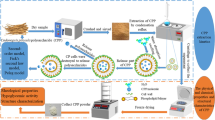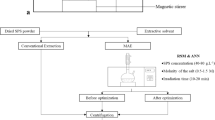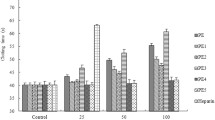Abstract
This study investigates Ophiopogon japonicas, a traditional Chinese medicine, by establishing the process model of polysaccharide precipitation based on a neural network algorithm. First, the principle of the BP neural network and the selection method of the model parameters are discussed, and the improved BP neural network algorithm is proposed. Then, the BP neural network model based on the population genetic algorithm (PGA) is established by analyzing the precipitation process of Ophiopogon japonicus polysaccharide. The weights and thresholds are trained and optimized to improve the precision of the polysaccharide precipitation model. Finally, the effect of the algorithm is illustrated by numerical simulation, and the simulation results are analyzed. This work lays the foundation for the future control system design.




Similar content being viewed by others
References
Wenzhong G, Shuanghua Y (1995) Industrial system modeling. Zhejiang University Press, Zhejiang, pp 73–75
Shunyan W, Jianxin Z, Jianhong LIU (2009) Researching of hybrid modeling method for chemical process. Manuf Autom 31(10):139–141
Jijun Y, Xiaoyang H, Chenhua X (2003) Hybrid modeling of sugar boiling process. Autom Technol Appl 13(1):1–5
Peng C, Haiguang Q, Guihua Y et al (2012) Optimization of extraction process of the roots of moghania philippinensis by central composite design and response surface method. Chin J Pharm Anal 32(12):2246–2252
Zhaoqi P, Shilin H, Xiaobei L et al (2013) Optimization of extraction technology for total phenolic acids from crepis turczaniowii by central composite design-response surface methodology. Chin J Exp Tradit Med Formul 19(21):20–23
Peng H, Fei G, Jingliu H et al (2013) Optimization of the extraction processing of total flavonodis and ployphenols from ‘MiZao’ jujube with quadratic regression orthogonal method. Sci Technol Food Ind 34(17):268–273
Yan S (2008) Research on data fusion technology of main parameters in sugar boiling process. Master Thesis of Guangxi University, pp 7–9
Jijun Y (2006) Dynamic matrix control of cane sugar crystallization process. Comput Meas Control 14(1):72–74
Tongyi W, Bing Z, Yuchun W (2006) Ultrasonic extraction process of longan polysaccharide by orthogonal test—artificial neural network model. Chin Tradit Herbal Drugs 37(10):1514–1516
Rui MA (2008) The principle of artificial neural network. Machinery Industry Press, Beijing, pp 23–25
Wei L (2009) The optimal control of sugar crystal process based on adaptive critic design method. Master Thesis of Guangxi University, pp 5–8
Chunli F, Minimalgri Z, Lingmei Wang (2009) Application of BP neural network in sugar crystal process model establishment. Comput Simul 26(5):100–102
Nan L, Ruibin L (2006) Neural network model and its application on control of boiling sugar. China Beet Sugar 44(3):2–5
Nan L, Ruibin L (2007) The algorithm of boiling sugar control based on neural networks. Micro Comput Inf 23(4):48–50
Xifan R, Yuanzhou C, Weiminimalg N (2003) Development of boiling sugar system based on artificial intelligent automation. Yunnan Metall 32(s1):150–154
Chunli F, Minimalgri Z (2009) Modeling and control of a batch sugar boiling process. Comput Syst Appl 18(3):38–41
Meng Z (2011) Experimental platform of sugar crystallization design and the control process’s simulation. Master Thesis of Guangxi University, pp 1–7
Qing S (2010) On the weight convergence of Elman networks. IEEE Trans Neural Netw 21(3):463–480
Shuang Q, Zhihong D (2004) A method of choosing BP network’s initial weights. J Northeast Normal Univ (Nat Sci Ed) 36(3):25–30
Kayama M et al. (1992) Modeling generalization capacity for a multi-layered Neural network classifier and optimizing its number of hidden unites. In: Proceedings of International Joint Conference on Neural Networks, pp 429–434
Watanabe E, Shimizu H (1993) Algorithm for pruning hidden units in multi-layered neural network for binary pattern classification problem. In: Proceedings of international joint conference on neural network, pp 327–330
Hecht-nielsen R (1987) Kolmogorov’’s mapping neural network existence theorem. In: Proceedings of the first IEEE international conference on neural networks, pp 265–271
Mirchandani G, Cao W (1989) On hidden nodes for neural nets. IEEE Trans Circuits Syst 36(5):661–664
Huang SC (1991) Bounds on the number of hidden neurons in multilayer perceptrons. IEEE Trans Neural Netw 2(1):47–55
Mehrotra KG, Mohan CK, Ranka S (1991) Bounds on the number of samples needed for neural learning. IEEE Trans Neural Netw 2(6):548–558
Wang H, Seng D (2006) BP algorithm and its application on store amount prediction. J Zhejiang Wat Cons Hydr Coll 8(4):34–37
Jiapei Y (2008) The research of improved BP algorithm based on self-adaptive learning rate. Master Thesis of Tianjin University, pp 24–25
Yaxiang Y, Wenyu S (1997) Optimization theory and method. Science Press, Beijing, pp 33–47
Liqun H (2007) Design and application of artificial neural network theory. Chemical Industry Press, Beijing, pp 43–48
Jacobs R (1988) Increased rates of convergence through learning rate adaptation. Neural Netw 1(88):295–307
Yongji W, Jian T (2003) Neural network control. Machinery Industry Press, Beijing, pp 18–20
Acknowledgments
This work is supported by the Natural Science Foundation of Hebei province (F2013501041), the Science and Technology Research and Development Project Funds of Shenzhen (JCYJ20120618142137681), and the Science and Technology Planning Project of Hebei province (13273303D).
Author information
Authors and Affiliations
Corresponding author
Rights and permissions
About this article
Cite this article
Duan, H., Ma, Z., Zhu, S. et al. Modeling and optimization of polysaccharide precipitation of traditional Chinese medicine injection. Int. J. Mach. Learn. & Cyber. 9, 893–902 (2018). https://doi.org/10.1007/s13042-016-0612-1
Received:
Accepted:
Published:
Issue Date:
DOI: https://doi.org/10.1007/s13042-016-0612-1




